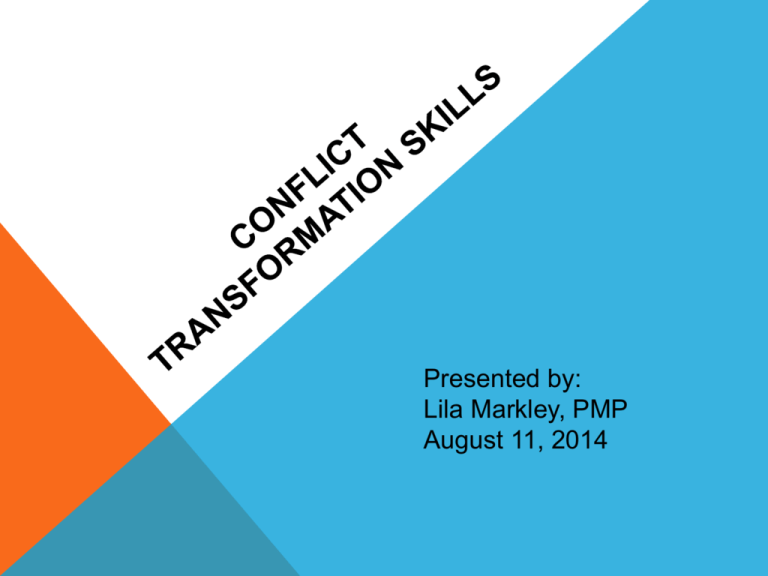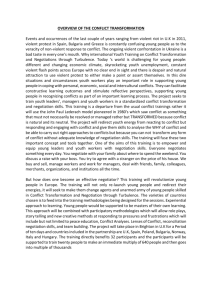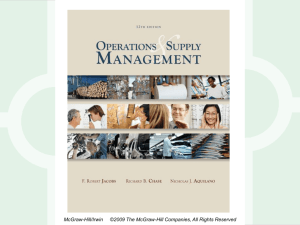PMI_Conflict_Transformation_08_2014_final
advertisement

Presented by: Lila Markley, PMP August 11, 2014 INTRODUCTION AND AGENDA Introduction • What is conflict? • Ingredients of conflict • Perspective counts • Approaches to conflict that don’t work! • From conflict management to conflict transformation • The conflict partnership • Steps to a partnership approach • What do you do when the mediation or negotiation is stuck • Breakthrough strategy steps • Case discussion • Close – The Meeting Place 2 WHAT IS CONFLICT Con`flict´ n. 1. A striking or dashing together; violent collision; as, a conflict of elements or waves. 2. A strife for the mastery; hostile contest; battle; struggle; fighting. v. i.1. To strike or dash together; to meet in violent collision; to collide. 2. To maintain a conflict; to contend; to engage in strife or opposition; to struggle. 3. To be in opposition; to be contradictory. http://www.webster-dictionary.org/definition/conflict “The best way to get rid of an enemy is to make it your friend.” Abraham Lincoln 3 INGREDIENTS OF CONFLICT Differences Diversity Feelings Values Perspective Needs Perceptions Principles Emotions When you consider the different possible combination of ingredients, each conflict takes on a unique flavor. 4 PERSPECTIVE Perspective counts! Conflict transformation requires that participants view the conflict through multiple lenses. • Immediate situation • Underlying patterns and context • Structure of the conflict and the relationships Conflict transformation is an evolution of conflict management and conflict resolution concepts. It is based on the theory that conflict is normal in relationships and it is a catalyst for change. What do you see when you look at the images on the next pages? 5 WHAT DO YOU SEE? 6 WHAT DO YOU SEE? 7 WHAT DO YOU SEE? What Psychologist's of perception call the Gestalt principle can be applied to the concept that we can sometimes miss the big picture of the conflict by focusing on specific aspects. 8 APPROACHES TO CONFLICT Traditional approaches that don’t work • Bargaining Focus on the demands of the participants rather than needs, perceptions, goals, values and feelings • Conquest Depends on bullying, dominance and manipulation • Band-Aid A quick fix that creates an illusion that the problem is solved • Avoidance • Role Playing Pretends there is no conflict because the participants don’t know how to deal with it Participants lose the opportunity to make valuable contributions because they are constrained by their roles 9 FROM CONFLICT MANAGEMENT TO CONFLICT TRANSFORMATION Conflict management does not attempt to remove conflict; rather, it looks at how to bring opposing sides together in a cooperative and constructive process for managing difference. Conflict resolution recognizes that people cannot compromise on their fundamental needs; however, it is possible to move beyond a conflict if participants can explore, analyze, question and reframe their positions and interests. Conflict transformation is a process of engaging with, and transforming the relationships, interest, discourses, and the constitution of a society that supports conflict. Constructive conflict is seen as a necessary agent or catalyst for change. 10 CONFLICT PARTNERSHIP Conflict transformation is an approach that advocates a conflict partnership. It is sustainable and meets the needs of the participants and overall relationship. • We, not I versus You • Looks at the overall relationship • Seeks to improve the relationship • Results in mutual benefit “What do you really want, and what will you do to keep from getting it?” William G. Perry, Jr. Harvard Graduate School of Education 11 KEY STEPS IN THE PARTNERSHIP APPROACH Steps key to a partnership approach in conflict transformation are: • Create an effective atmosphere • Clarify perceptions • Focus on shared interests and needs • Build shared positive power • Look to the future, then learn from the past • Generate options • Develop stepping stones to action • Make mutual benefit agreements Dudley Weeks, The Eight Essential Steps to Conflict Resolution 12 PRINCIPLED BASED NEGOTIATION Roger Fisher and William Ury, in their book Getting to Yes talk about principled based negotiation. Here are some key points to consider: • Don’t bargain over positions. • Separate people from the problem. • Focus on interests and not positions. • Invent options for mutual gain. • Insist on using objective criteria for making decisions. • Have a best alternative for the negotiated agreement (BATNA). 13 WHAT DO YOU DO WHEN YOU ARE STUCK In his book, Getting Past No: Negotiating In Difficult Situations, William Ury presents the Breakthrough Strategy which consists of a few critical steps to getting beyond a stalemate. However, before you even start it is important to PREPARE, PREPARE, PREPARE! Most negotiations end before they even start. Breakthrough Strategy 1. Go to the balcony 2. Step to their side 3. Reframe 4. Build them a golden bridge 5. Use power to educate Build your opponent a golden bridge to retreat across. – Sun Tzu 14 To Outsource or Not to Outsource That is the Question Case Discussion 15 CLOSING The Meeting Place “If we create the social space that brings Truth, Mercy, Justice and Peace together within a conflicted group or setting, energy is crystallized that creates deeper understanding and unexpected new paths leading toward restoration and reconciliation.” John Paul Lederach http://www.colorado.edu/conflict/transfo rm/jplchpt.htm 16 REFERENCES AND FURTHER READING Lederach, John P. (2003). The little book of conflict transformation. Intercourse: Good Books. Kegan, R., & Lahey, L. (2001). How the way we talk can change the way we work. San Francisco: Jossey- BassBeer. Fisher,R. & Ury, W. (2011). Getting to yes. New York: Penguin Books. (revised addition) Weeks, Dudley. (1992). The eight essential steps to conflict resolution. New York: Penguin Books Ury, W. (1993). Getting past no: negotiating in difficult situations. New York: Penguin Books. Lederach, John P. (1997). The meeting place. Retrieved from http://www.colorado.edu/conflict/transform/jplchpt.htm 17







